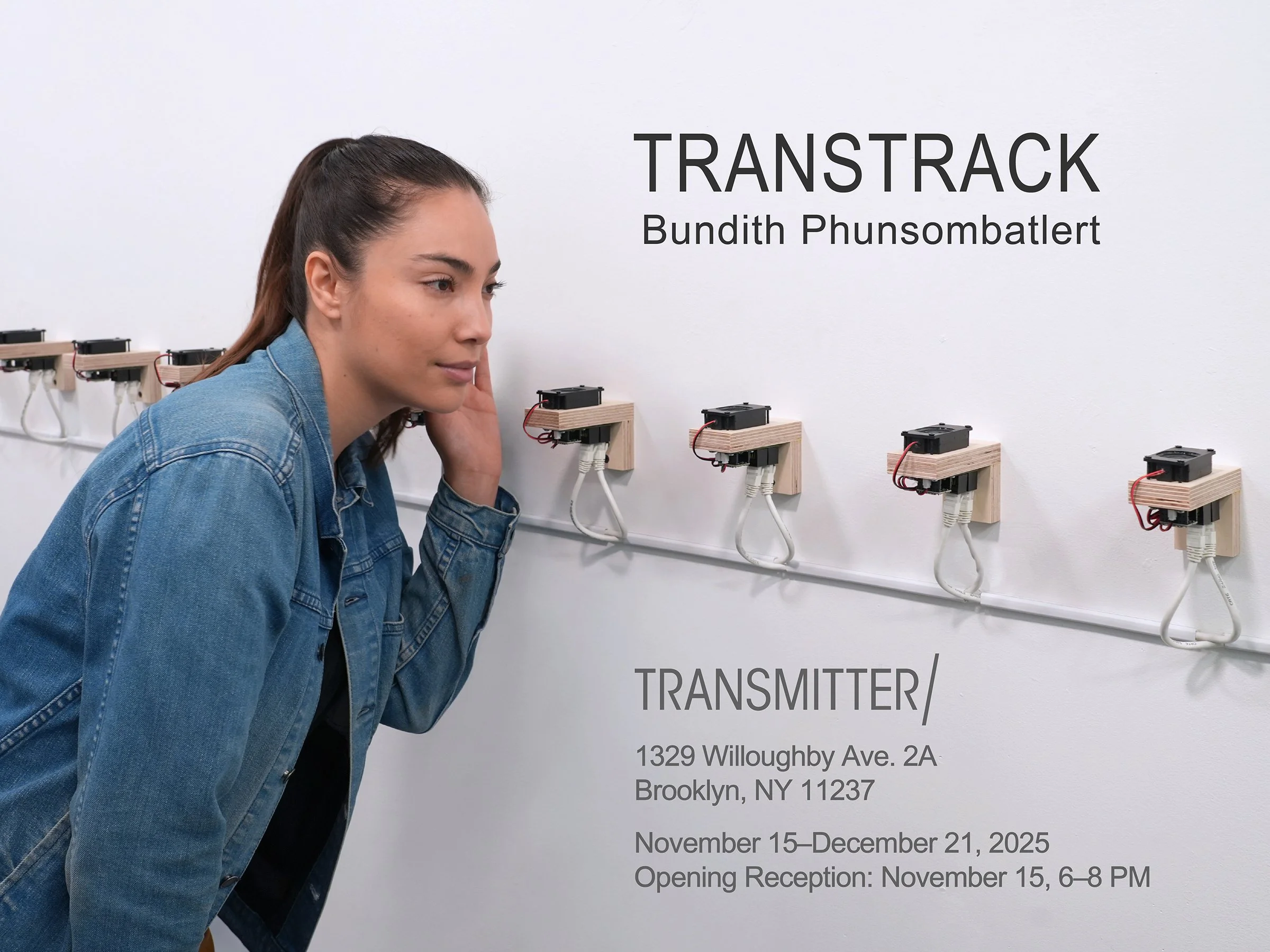Transtrack
Bundith Phunsombatlert
On View: November 15–December 21, 2025
Opening Reception: November 15, 6–8 PM
Photography courtesy of Bundith Phunsombatlert
Transmitter proudly presents Transtrack, a new multimedia installation by artist Bundith Phunsombatlert. Building on Phunsombatlert’s community-centered practice and ongoing exploration of oral immigration histories gathered from local elders, the exhibition invites participants from diverse backgrounds to share memories of landscape and migration, fostering moments of cross-cultural connection. Transtrack transforms the idea of a train platform into a multisensory space where the voices of elderly immigrants recount life journeys, weaving an immersive landscape of sound and story.
Along the gallery wall, a series of loudspeakers emitting sound and vibration are arranged in a line, mimicking the appearance of train tracks. The speakers vibrate one after another like a passing train, gradually fading. As the noise dissipates, the viewer is encouraged to move closer to each speaker to hear the gentle recordings of participants’ memories. This shifting soundscape reflects the intimate and emotional terrain of immigration, where the past is never still and stories unfold like passing landscapes through a train window.
In the center of the gallery, a small waiting area serves as a recording site for new narratives. Elders are invited to come with their descendants or younger generations, who help retell and record their stories within this structure, fostering intergenerational connectivity. Transparent partitions around the waiting area allow observers to participate in the process. A posted train schedule informs visitors of upcoming “train” arrivals, or the programmed changes in audio. Each participant’s story shifts and replaces others after every “train” passes. This random rotation, controlled by a computer system, mirrors the changing flow of passengers at stations. New recordings will be added throughout the exhibition.
Through embodied experiences of sonic archiving and physical vibration, the project amplifies overlooked immigrant voices and honors generations of unheard laborers whose contributions to our shared infrastructure, like those of Chinese and other immigrants who built the American transcontinental railroad, are absent from dominant historical narratives. With a focus on decolonizing traditional archives, the work collects and consolidates these oral histories from local elders as knowledge-holders, creating a multisensory experience where vibration and narrative merge into a bodily encounter, while showcasing human interconnectedness and the richness of our global diaspora.
More than an artwork, Transtrack is a living archive that reshapes how immigration history and memory are preserved, portrayed, and represented through contemporary media. The project materializes the invisible through movement, voice, and vibration—constructing an archive that is sensory rather than visual, participatory rather than observational, and constantly in flux—just like the diaspora experience it embodies. By merging contemporary technologies with traditional forms of media, Transtrack offers a unique definition of “new” media defined not simply by the use of emergent technology, but by utilizing a “new” methodological approach to established practices of storytelling.
*Transtrack can be installed at multiple locations, synchronized by a computer system accessible through the internet. This feature allows the virtual train to journey to different platforms according to confirmed schedules, expanding the project’s reach.
The project was supported, in part, by a Foundation for Contemporary Arts Emergency Grant, whose generous support made this work possible.
Artist Biography
Bundith Phunsombatlert is a New York-based artist originally from Thailand. As a first-generation immigrant, his recent work draws on personal and shared immigrant experiences, exploring identity not only through connections between origins and destinations, but also through the relational spaces that connect individuals.
He has exhibited internationally at institutions including the Auckland Triennial (New Zealand), Guangzhou Triennial (China), Museum of Contemporary Art Kiasma (Finland), the National Gallery (Thailand), and the Asia Pacific Triennial (Australia). His recent exhibitions have been at the Brooklyn Public Library (Central), the Bronx Museum of the Arts, and the Katonah Museum of Art, all in New York.
Phunsombatlert has received grants and residencies from organizations such as the Pollock-Krasner Foundation, New York State Council on the Arts, Adolph and Esther Gottlieb Foundation, MacDowell Colony, Brooklyn Public Library, Brooklyn Arts Fund, Center for Book Arts (New York), Harpo Foundation, Eyebeam, Skowhegan, Asian Cultural Council, the Second Prize, UNESCO Digital Arts Award at the 12th International Symposium on Electronic Arts, and the Grand Prize at the Contemporary Art Exhibition in Thailand.
His projects have been featured in various publications, including the Wall Street Journal, Prospect Art’s One Work Publishing Program, Two Times of Art in Print’s Prix de Print, Public Art Review, Artnet News, Hyperallergic, Art Asiapacific, and Asian Art News. Phunsombatlert holds an MFA in Digital+Media from the Rhode Island School of Design (RISD) and a BFA/MFA in Printmaking from Silpakorn University in Thailand.
The project features the stories of Aida Ramos, Efrain Aviles, Jose A. Felix, Julia Nunez, Margarita Melendez, Maria Maisonet, Martha Dell, Rebecca Abrams, and Vere Gibbs, among others.
With special thanks to Aida Ramos’ family (Candita Ramos-Montes, Alyssa Luz Montes, Nyori Kennedy Stephens), Bảo Châu Thiệu Nguyễn, Camille Eskell, Danny C, Danny M, Eunice Chen, Eunjung Kim, Ezer Longinus, Hani Elhor, HC Huỳnh, Hayoon-Jay Lee, Hyun Joo Linder, Jan Mun, Nazli Efe, Nicole Linder, Rob Herschenfeld, Sarah Langenbach, Steve Antonelli, and Yesenia Linares; Transmitter: Carl Gunhouse, Genevieve Lowe, Lila Nazemian, and Vincent Stracquadanio; and very special thanks to Eva Mayhabal Davis and Sofia Thiệu D'Amico.








